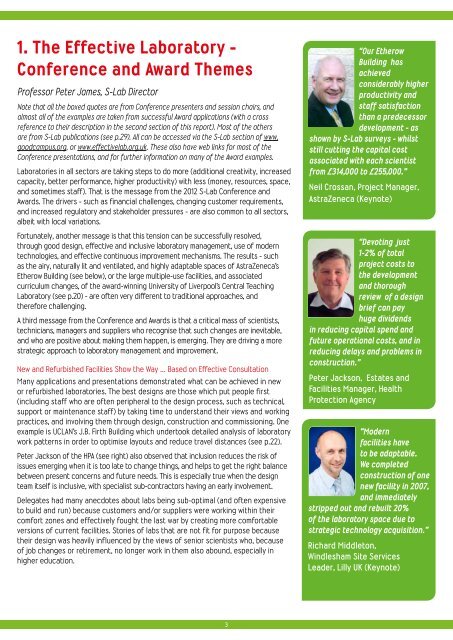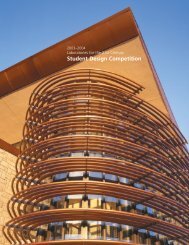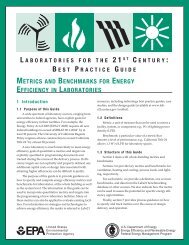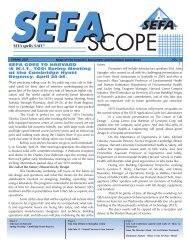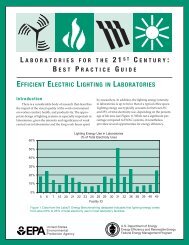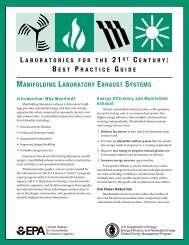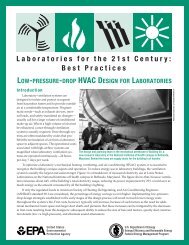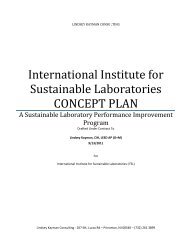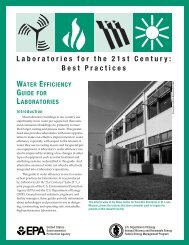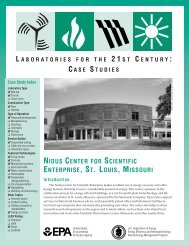Results of the 2012 S-Lab Awards and Conference The Effective ...
Results of the 2012 S-Lab Awards and Conference The Effective ...
Results of the 2012 S-Lab Awards and Conference The Effective ...
You also want an ePaper? Increase the reach of your titles
YUMPU automatically turns print PDFs into web optimized ePapers that Google loves.
1. <strong>The</strong> <strong>Effective</strong> <strong>Lab</strong>oratory -<br />
<strong>Conference</strong> <strong>and</strong> Award <strong>The</strong>mes<br />
Pr<strong>of</strong>essor Peter James, S-<strong>Lab</strong> Director<br />
Note that all <strong>the</strong> boxed quotes are from <strong>Conference</strong> presenters <strong>and</strong> session chairs, <strong>and</strong><br />
almost all <strong>of</strong> <strong>the</strong> examples are taken from successful Award applications (with a cross<br />
reference to <strong>the</strong>ir description in <strong>the</strong> second section <strong>of</strong> this report). Most <strong>of</strong> <strong>the</strong> o<strong>the</strong>rs<br />
are from S-<strong>Lab</strong> publications (see p.29). All can be accessed via <strong>the</strong> S-<strong>Lab</strong> section <strong>of</strong> www.<br />
goodcampus.org, or www.effectivelab.org.uk. <strong>The</strong>se also have web links for most <strong>of</strong> <strong>the</strong><br />
<strong>Conference</strong> presentations, <strong>and</strong> for fur<strong>the</strong>r information on many <strong>of</strong> <strong>the</strong> Award examples.<br />
<strong>Lab</strong>oratories in all sectors are taking steps to do more (additional creativity, increased<br />
capacity, better performance, higher productivity) with less (money, resources, space,<br />
<strong>and</strong> sometimes staff). That is <strong>the</strong> message from <strong>the</strong> <strong>2012</strong> S-<strong>Lab</strong> <strong>Conference</strong> <strong>and</strong><br />
<strong>Awards</strong>. <strong>The</strong> drivers - such as financial challenges, changing customer requirements,<br />
<strong>and</strong> increased regulatory <strong>and</strong> stakeholder pressures - are also common to all sectors,<br />
albeit with local variations.<br />
Fortunately, ano<strong>the</strong>r message is that this tension can be successfully resolved,<br />
through good design, effective <strong>and</strong> inclusive laboratory management, use <strong>of</strong> modern<br />
technologies, <strong>and</strong> effective continuous improvement mechanisms. <strong>The</strong> results - such<br />
as <strong>the</strong> airy, naturally lit <strong>and</strong> ventilated, <strong>and</strong> highly adaptable spaces <strong>of</strong> AstraZeneca’s<br />
E<strong>the</strong>row Building (see below), or <strong>the</strong> large multiple-use facilities, <strong>and</strong> associated<br />
curriculum changes, <strong>of</strong> <strong>the</strong> award-winning University <strong>of</strong> Liverpool’s Central Teaching<br />
<strong>Lab</strong>oratory (see p.20) - are <strong>of</strong>ten very different to traditional approaches, <strong>and</strong><br />
<strong>the</strong>refore challenging.<br />
A third message from <strong>the</strong> <strong>Conference</strong> <strong>and</strong> <strong>Awards</strong> is that a critical mass <strong>of</strong> scientists,<br />
technicians, managers <strong>and</strong> suppliers who recognise that such changes are inevitable,<br />
<strong>and</strong> who are positive about making <strong>the</strong>m happen, is emerging. <strong>The</strong>y are driving a more<br />
strategic approach to laboratory management <strong>and</strong> improvement.<br />
New <strong>and</strong> Refurbished Facilities Show <strong>the</strong> Way … Based on <strong>Effective</strong> Consultation<br />
Many applications <strong>and</strong> presentations demonstrated what can be achieved in new<br />
or refurbished laboratories. <strong>The</strong> best designs are those which put people first<br />
(including staff who are <strong>of</strong>ten peripheral to <strong>the</strong> design process, such as technical,<br />
support or maintenance staff) by taking time to underst<strong>and</strong> <strong>the</strong>ir views <strong>and</strong> working<br />
practices, <strong>and</strong> involving <strong>the</strong>m through design, construction <strong>and</strong> commissioning. One<br />
example is UCLAN’s J.B. Firth Building which undertook detailed analysis <strong>of</strong> laboratory<br />
work patterns in order to optimise layouts <strong>and</strong> reduce travel distances (see p.22).<br />
Peter Jackson <strong>of</strong> <strong>the</strong> HPA (see right) also observed that inclusion reduces <strong>the</strong> risk <strong>of</strong><br />
issues emerging when it is too late to change things, <strong>and</strong> helps to get <strong>the</strong> right balance<br />
between present concerns <strong>and</strong> future needs. This is especially true when <strong>the</strong> design<br />
team itself is inclusive, with specialist sub-contractors having an early involvement.<br />
Delegates had many anecdotes about labs being sub-optimal (<strong>and</strong> <strong>of</strong>ten expensive<br />
to build <strong>and</strong> run) because customers <strong>and</strong>/or suppliers were working within <strong>the</strong>ir<br />
comfort zones <strong>and</strong> effectively fought <strong>the</strong> last war by creating more comfortable<br />
versions <strong>of</strong> current facilities. Stories <strong>of</strong> labs that are not fit for purpose because<br />
<strong>the</strong>ir design was heavily influenced by <strong>the</strong> views <strong>of</strong> senior scientists who, because<br />
<strong>of</strong> job changes or retirement, no longer work in <strong>the</strong>m also abound, especially in<br />
higher education.<br />
“Our E<strong>the</strong>row<br />
Building has<br />
achieved<br />
considerably higher<br />
productivity <strong>and</strong><br />
staff satisfaction<br />
than a predecessor<br />
development - as<br />
shown by S-<strong>Lab</strong> surveys - whilst<br />
still cutting <strong>the</strong> capital cost<br />
associated with each scientist<br />
from £314,000 to £255,000.”<br />
Neil Crossan, Project Manager,<br />
AstraZeneca (Keynote)<br />
“Devoting just<br />
1-2% <strong>of</strong> total<br />
project costs to<br />
<strong>the</strong> development<br />
<strong>and</strong> thorough<br />
review <strong>of</strong> a design<br />
brief can pay<br />
huge dividends<br />
in reducing capital spend <strong>and</strong><br />
future operational costs, <strong>and</strong> in<br />
reducing delays <strong>and</strong> problems in<br />
construction.”<br />
Peter Jackson, Estates <strong>and</strong><br />
Facilities Manager, Health<br />
Protection Agency<br />
“Modern<br />
facilities have<br />
to be adaptable.<br />
We completed<br />
construction <strong>of</strong> one<br />
new facility in 2007,<br />
<strong>and</strong> immediately<br />
stripped out <strong>and</strong> rebuilt 20%<br />
<strong>of</strong> <strong>the</strong> laboratory space due to<br />
strategic technology acquisition.”<br />
Richard Middleton,<br />
Windlesham Site Services<br />
Leader, Lilly UK (Keynote)<br />
3


